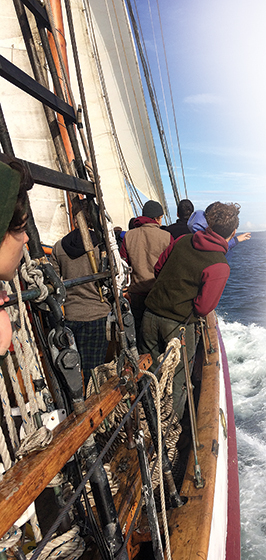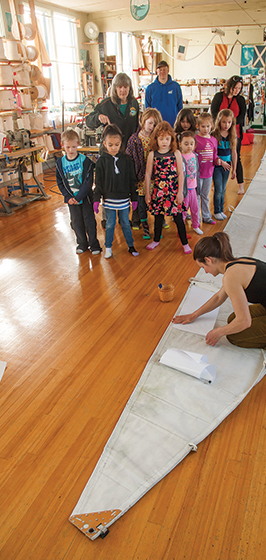Hoisting Sails
Maritime Discovery Schools Initiative Helps Teachers Foster the Next Generation of Maritime Workers
 On a drizzly day early this fall, more than 130 first and second graders from Grant Street Elementary crawled in their stocking feet from the dock onto the deck of the schooner Martha. After setting off for a cruise around Port Townsend Bay, Captain Robert d’Arcy let the students unfurl a sail and taught them names of boat parts. Similarly, last spring another group of Grant Street Elementary students climbed the steep, well-worn stairway leading to Hasse & Company/Port Townsend Sails, where they watched as canvas was sewn into sails.
On a drizzly day early this fall, more than 130 first and second graders from Grant Street Elementary crawled in their stocking feet from the dock onto the deck of the schooner Martha. After setting off for a cruise around Port Townsend Bay, Captain Robert d’Arcy let the students unfurl a sail and taught them names of boat parts. Similarly, last spring another group of Grant Street Elementary students climbed the steep, well-worn stairway leading to Hasse & Company/Port Townsend Sails, where they watched as canvas was sewn into sails.
Place-based education that moves kids out of the classroom and onto a schooner or up to a sail loft is an increasingly accepted form of learning and a specialty of the Maritime Discovery Schools Initiative (MDS) located in Port Townsend, Washington. An innovation of the local school district and many collaborators including the Northwest Maritime Center, the primary goal of MDS is to give students early exposure to Port Townsend’s rich maritime heritage and industry by getting them out on the water and into marine-related businesses. With support from Washington Sea Grant and numerous donors, MDS has partnered with local maritime businesses and nonprofit organizations to expose all K-12 students to the maritime experience over a five-year period.
The need to introduce our youth to ocean-related skills is becoming urgent. Washington’s maritime sector makes an important annual contribution of $38 billion to the state’s overall economy. But the associated workforce is aging, with only 35 percent of the workforce now between the ages of 16 and 39. The job pipeline isn’t attracting enough new workers to replace older workers as they retire, and many youth are not staying in the area to work once they graduate from high school. The median age in Jefferson County, where Port Townsend is located, is 57.5 — the oldest in the state.
Recognizing the urgency, the Port Townsend maritime business and education communities joined forces to rebuild the maritime workforce while improving upon their children’s education in a remarkable example of innovative cooperation. Local business owner Carol Hasse, of Hasse & Company/Port Townsend Sails, believes that giving students maritime experience early on could awaken something within them. “Moving with the wind is not only a joy, but a skill that we need,” she says. “For thousands of years all commerce was conducted by sail. It is in our DNA; it is our history.”

A group of students from Grant Street School watch as a sail is being cut and prepared for sewing during a tour led by Carol Hasse of Hasse & Company/Port Townsend Sails. Photo by Chris Tucker, Port Townsend Leader, 2016.
Ms. Hasse’s enthusiasm is shared by many other local business owners and entrepreneurs in the community. “It is phenomenal to see the high level of involvement in the initiative, with over 70 partners engaged from every sector of the community,” Sarah Rubenstein, director of MDS adds. “Sea Grant funds have furthered the project by supporting the teachers and their training so they could make it a reality. The teachers have planned curriculum, trained in maritime skills and interacted with each other in close collaboration with the Northwest Maritime Center.”
In 2016, with the Sea Grant funding support, Port Townsend educators worked with eight industry partners to hold a series of three-day, place-based workshops. MDS also held curriculum development sessions during the school year, where 90 teachers learned about the breadth of maritime jobs and how to prepare their students for the industry.
Forty-nine teachers participated in immersive summer workshops, visiting maritime employees in their work environments. Experiences included a tour of an operating ferry, a day onsite with a shellfish survey team and a tour of a shipyard in Port Townsend at the Shipwrights Co-op, where historic ships are being restored. The tour even included a visit to the Western Flyer, the historic vessel that John Steinbeck sailed on when he wrote the Sea of Cortez.
Although MDS’s place-based curriculum integrating maritime skills may seem like a radical educational approach, it has many predecessors. These include the New York Harbor School in Brooklyn, the Raisbeck Aviation High School in Tukwila and San Diego’s High Tech High.
“Lots of kids have never dreamt you could sail on the water, let alone live and work on the water,” Hasse says. “Hands-on connections are missing in public education generally and that is what we are providing [through MDS]. The maritime program actually goes beyond career training and provides students with an opportunity for self-expression and shows them how they can learn and teach themselves.”
While the MDS program isn’t a cure-all for the industry’s workforce woes, it is building skills and connections to the maritime sector for hundreds of Port Townsend students. With dedicated community partners collaborating with educators, it looks like the future of the Port Townsend maritime industry will have smooth sailing ahead.
By MaryAnn Wagner